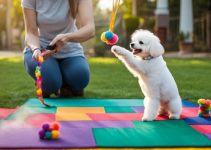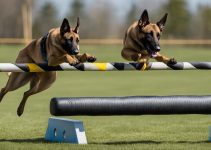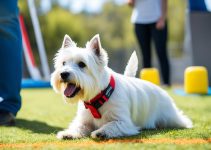Welcome to my comprehensive Keeshond training guide! In this guide, I will provide you with valuable tips and techniques to successfully train your Keeshond using positive reinforcement methods. Whether you are focusing on obedience training, puppy training, or behavioral training, this guide has got you covered. I have gathered all the essential information from various reliable sources to ensure you have the best resources for training your beloved Keeshond.
Keeshond training is an exciting journey that will strengthen the bond between you and your furry companion. With the right approach and techniques, you can mold your Keeshond into a well-behaved and obedient dog.
Keeshond Training
- Positive reinforcement training is highly effective for Keeshonds.
- Understanding the behavior of Keeshond puppies and dogs is crucial for successful training.
- Crate training provides a safe and comfortable space for your Keeshond.
- Socializing your Keeshond from an early age helps them become friendly and confident.
- Dealing with common behavioral issues requires patience and consistent training.
The Characteristics of a Keeshond Puppy and Dog
Keeshonds have unique characteristics that require specific training approaches. Understanding the behavior of Keeshond puppies and dogs is essential for effective training.
When it comes to keeshond behavior, it’s important to consider their temperament, energy levels, and socialization needs. Keeshonds are known for their friendly and affectionate nature, making them excellent family pets. They are also highly intelligent and eager to please, which means they respond well to positive reinforcement training methods.
Keeshond puppies are playful and curious, and they require proper keeshond puppy training to develop good behavior habits. Starting training at an early age helps with teaching them basic commands, potty training, and how to interact with people and other animals.
Obedience training is crucial for keeshonds to ensure they grow up to be well-behaved and obedient companions. It establishes boundaries, helps to curb unwanted behaviors, and strengthens the bond between you and your furry friend.
The Importance of Socialization
One key aspect of keeshond behavior training is socialization. Keeshonds are naturally sociable dogs, but early and proper socialization is essential to help them become well-rounded and confident individuals.
- Expose your keeshond puppy to different environments and situations, such as parks, busy streets, and other places with a variety of sounds and smells.
- Introduce your puppy to different people, including adults, children, and people from diverse backgrounds, to help them become comfortable with different types of human interactions.
- Allow your keeshond to interact with other dogs under controlled circumstances, such as puppy playdates or supervised visits to dog parks.
Proper socialization helps prevent fearfulness, aggression, and anxiety in keeshonds. It also paves the way for positive interactions with people and other animals throughout their lives.
By understanding the unique characteristics of keeshonds and providing the right training, including keeshond puppy training and keeshond obedience training, you can shape their behavior and ensure they become well-behaved and obedient companions.
Crate Training Your Keeshond: A Step-by-Step Guide
Crate training is an essential part of training your Keeshond puppy. It provides them with a safe and comfortable space while helping you establish boundaries and promote good behavior. In this section, I will guide you through the process of crate training your Keeshond step-by-step.
The Benefits of Crate Training
Crate training offers numerous benefits for both you and your Keeshond. It provides a den-like environment where your puppy can feel secure and relaxed. Crate training also helps with housebreaking, as dogs instinctively avoid soiling their sleeping areas. Additionally, crates can be useful for travel, visits to the veterinarian, and managing separation anxiety.
Choosing the Right Crate
When selecting a crate for your Keeshond, make sure it is the appropriate size. It should be large enough for your puppy to stand, turn around, and lie down comfortably. However, avoid choosing a crate that is too spacious, as it may encourage your puppy to use one corner as a bathroom.
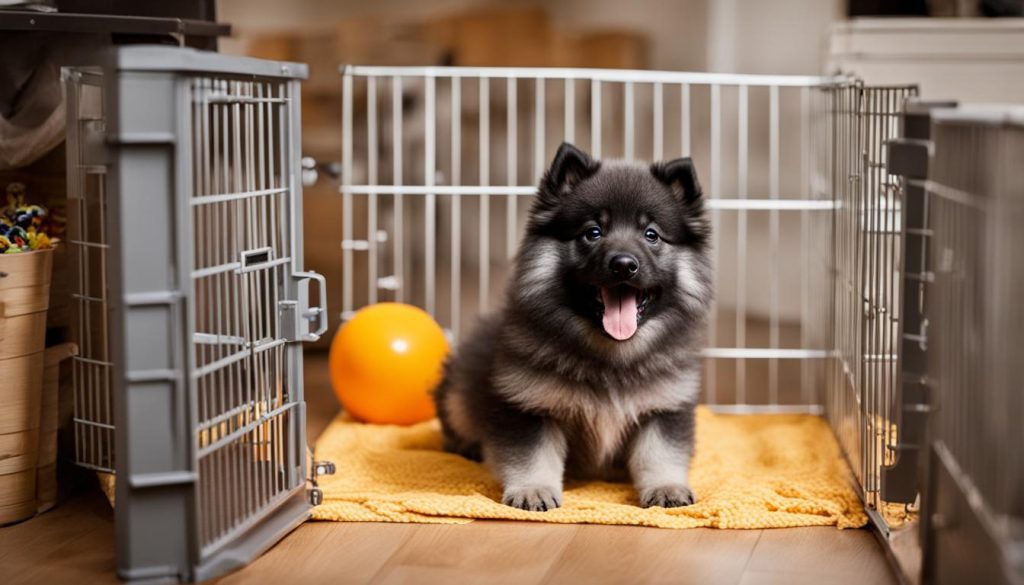
Introducing Your Puppy to the Crate
To introduce your Keeshond to the crate, make it a positive and enjoyable experience. Place treats or toys inside the crate to entice your puppy to explore. Use positive reinforcement by praising and rewarding them when they willingly enter the crate. Gradually increase the time your puppy spends inside the crate, starting with short intervals and gradually extending them.
Gradually Increasing Crate Time
As your Keeshond becomes more comfortable with the crate, gradually increase the amount of time they spend inside. Begin by closing the crate door for a few minutes while you remain close by. Gradually extend the time, always ensuring your puppy feels safe and secure. Remember to offer treats and praise when your Keeshond remains calm and relaxed inside the crate.
Crate training takes time and patience, but with consistent practice and positive reinforcement, your Keeshond will learn to see their crate as a cozy retreat. Remember to never use the crate as a form of punishment and always provide your puppy with plenty of exercise and mental stimulation outside of crate time.
Socializing Your Keeshond: Tips and Techniques
Proper socialization is crucial for a well-rounded and confident Keeshond. As a responsible dog owner, it’s important to expose your Keeshond to various people, animals, and environments to ensure they grow up to be friendly, outgoing, and well-behaved in social settings.
First and foremost, always prioritize positive experiences during socialization. This means creating a safe and comfortable environment for your Keeshond during new encounters. Start socializing your Keeshond from a young age, as early exposure to different situations will help them become more adaptable and less fearful.
To introduce your Keeshond to new situations and stimuli, follow these Keeshond training tips:
- Begin socializing your Keeshond by introducing them to familiar people and allowing them to interact in a controlled and positive manner.
- Gradually expose your Keeshond to unfamiliar people, always ensuring they are gentle and friendly.
- Arrange playdates with friendly and well-behaved dogs to promote positive interactions and good dog-to-dog social skills.
- Take your Keeshond for walks in different environments, such as parks and busy streets, to expose them to various sights, sounds, and smells.
- Consider enrolling your Keeshond in training classes or socialization classes specifically designed for dogs to interact with each other in a controlled environment.
Remember, positive reinforcement is key during socialization. Praise and reward your Keeshond whenever they exhibit calm and friendly behavior. Use treats and verbal cues to reinforce positive social interactions.
By following these socialization tips and techniques, you can help your Keeshond develop good social skills, build confidence, and become a well-mannered companion in any social setting.
Positive Reinforcement Training Methods for Keeshonds
Positive reinforcement training is a highly effective and humane approach to train your Keeshond. By focusing on rewarding desired behaviors, you can create a positive and enjoyable training experience for both you and your furry friend. Here, I will discuss the benefits of positive reinforcement training and provide you with techniques and resources to effectively train your Keeshond.
The Benefits of Positive Reinforcement
Positive reinforcement training utilizes rewards, praise, and treats to reinforce desired behaviors. This approach helps build trust and strengthens the bond between you and your Keeshond. Unlike punishment-based methods, positive reinforcement promotes a cooperative and eager-to-learn attitude in your dog.
When you reward your Keeshond for performing a command correctly, they associate the action with a positive outcome. This positive association motivates them to repeat the behavior in the future, making training more effective and enjoyable.
Training Techniques with Rewards, Praise, and Treats
When training your Keeshond, it is essential to establish clear communication and consistency. Here are some techniques for using rewards, praise, and treats effectively:
- Choose small and easily edible treats that your Keeshond finds highly rewarding.
- Timing is crucial – offer the reward immediately after your Keeshond performs the desired behavior.
- Pair the reward with verbal praise or a cue word to reinforce the association between the behavior and the reward.
- Vary the types of rewards to keep your Keeshond engaged and motivated.
- Gradually reduce the frequency of treats as your Keeshond becomes proficient in the behavior.
Remember to be patient, consistent, and always maintain a positive attitude during Keeshond training sessions. Your Keeshond will respond best to encouragement and positive reinforcement.
Essential Commands for Your Keeshond
Teaching your Keeshond basic commands is an important part of their training. Here are some essential commands to focus on:
- Sit
- Stay
- Come
- Down
- Leave it
- Drop it
These commands form the foundation of obedience and can help keep your Keeshond safe in various situations. Remember to start with short training sessions and gradually increase the duration as your Keeshond becomes more comfortable and responsive to the commands.
Resources and Exercises for Keeshond Training
There are several resources available to assist you in your Keeshond’s training journey. From online tutorials to training books and classes, you can find various options to suit your preferences and needs.
Here are some recommendations:
- American Kennel Club (AKC) – The AKC provides a range of training resources, including informational articles, training videos, and access to local training clubs.
- Keeshond Club of America – The official club website offers breed-specific training advice and resources.
- Training Books – Consider books written by renowned dog trainers that focus on positive reinforcement techniques.
In addition to utilizing these resources, regular Keeshond training exercises are crucial to reinforce their training and maintain their skills. Daily practice and consistency will help your Keeshond become a well-trained and obedient companion.
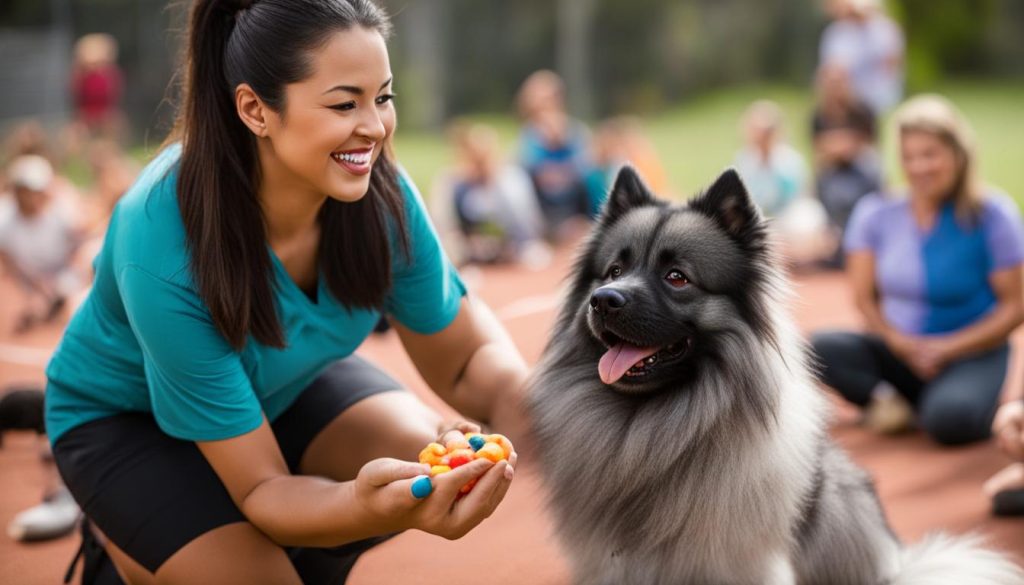
Incorporate positive reinforcement training methods into your Keeshond’s training routine to create a strong bond and foster a cooperative and well-behaved companion. With patience, consistency, and kindness, you can achieve great results in training your Keeshond.
Dealing with Common Behavioral Issues in Keeshonds
As a Keeshond owner, it’s important to address and resolve common behavioral issues that your furry friend may exhibit. By understanding their behavior and implementing effective training techniques, you can help your Keeshond develop positive behavior patterns. Let’s explore some of the frequently encountered behavioral problems in Keeshonds and discover tips to overcome them.
-
Potty Training Mistakes
One common issue Keeshond owners face is potty training mistakes. To tackle this problem, establish a consistent schedule for bathroom breaks and reward your Keeshond with praise and treats when they eliminate in the designated area. Be patient and persistent during the potty training process, as accidents may happen. Utilize positive reinforcement techniques to reinforce desired behavior.
-
Separation Anxiety
Keeshonds are known to be loyal and affectionate, which can sometimes result in separation anxiety when left alone. To alleviate separation anxiety, gradually introduce your Keeshond to alone time by starting with short periods and gradually increasing the duration. Provide them with stimulating toys and a comfortable space to help them feel secure. Using positive reinforcement techniques, reward calm and relaxed behavior when you leave and return home.
-
Excessive Barking
If your Keeshond has a tendency to bark excessively, it’s crucial to address this behavior. Identify the triggers that cause excessive barking, such as boredom or attention-seeking, and redirect their focus with interactive toys or mental stimulation. Engaging your Keeshond in regular exercise and providing obedience training can also help reduce excessive barking. Reward moments of quiet and reinforce calm behavior through positive reinforcement.
-
Jumping on People
Jumping on people is a behavior that can be both frustrating and potentially harmful. Teach your Keeshond alternative behaviors, such as sitting or offering a paw, to replace jumping. Practice consistent training by rewarding them for displaying appropriate greetings. Encourage family members and visitors to ignore your Keeshond when they jump, as any attention can reinforce the behavior. Consistency and positive reinforcement are key to eliminating this habit.
Implementing these tips and training techniques can help you overcome common behavioral issues in your Keeshond and foster a well-behaved and balanced companion. Remember to remain patient, consistent, and always use positive reinforcement methods. With time and dedication, you can shape your Keeshond’s behavior and strengthen your bond together.
Conclusion
I hope you found this guide on Keeshond training valuable and informative. By implementing the tips and techniques provided, you can effectively train your Keeshond and nurture a strong bond with your furry companion. Remember, patience and consistency are key when training a Keeshond.
With a professional approach to keeshond training, utilizing positive reinforcement and understanding their behavior, you can achieve great results. Whether you are teaching basic commands or addressing behavioral issues, using positive reinforcement methods will yield better outcomes and create a harmonious environment at home.
So, start practicing the keeshond training commands and techniques outlined in this guide. Consistency and dedication will be rewarded with a well-trained and obedient Keeshond. If you encounter any challenges along the way, don’t hesitate to seek professional keeshond training assistance.
Remember, a well-trained Keeshond is a happy and well-adjusted companion. So, embrace the journey of training your Keeshond and enjoy the loving and loyal bond that comes with it. Happy Keeshond training!
FAQ
What are the key training tips for Keeshonds?
Key training tips for Keeshonds include using positive reinforcement techniques, being consistent, and providing regular exercise and mental stimulation.
What is the best age to start training a Keeshond puppy?
It is recommended to start training a Keeshond puppy as early as 8 weeks old to establish good behavior habits and socialization skills.
How do I crate train my Keeshond puppy?
Crate training involves introducing your Keeshond to the crate gradually, using positive reinforcement, and creating a comfortable and safe space for them.
How can I socialize my Keeshond?
Socializing a Keeshond involves exposing them to various people, animals, and environments, starting at a young age, and ensuring positive experiences during interactions.
What are some essential commands to teach my Keeshond?
Essential commands to teach your Keeshond include sit, stay, come, down, leave it, and heel. These commands can be taught using positive reinforcement training techniques.
What are some common behavioral issues in Keeshonds?
Common behavioral issues in Keeshonds include potty training mistakes, separation anxiety, excessive barking, and jumping on people. These issues can be addressed through training and positive reinforcement.
How long does it take to train a Keeshond?
The time it takes to train a Keeshond can vary depending on the individual dog and consistency of training. It is important to be patient, consistent, and use positive reinforcement methods for the best results.



